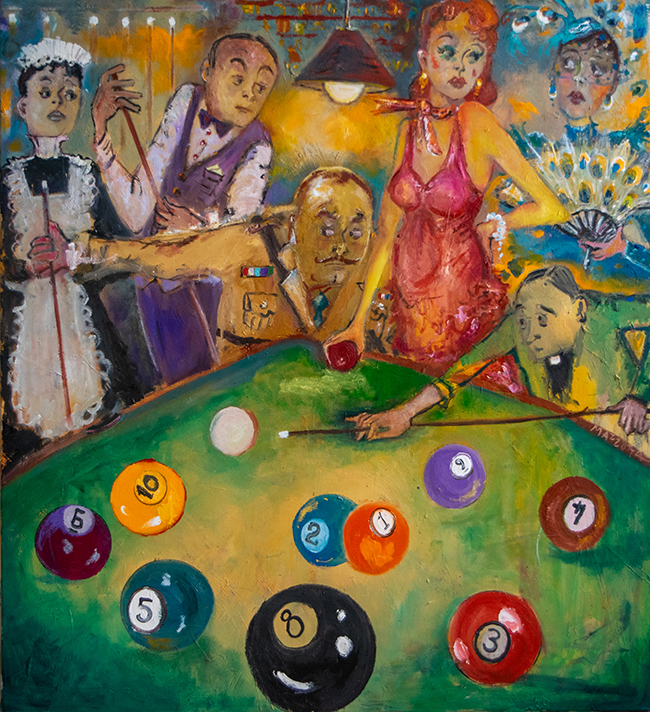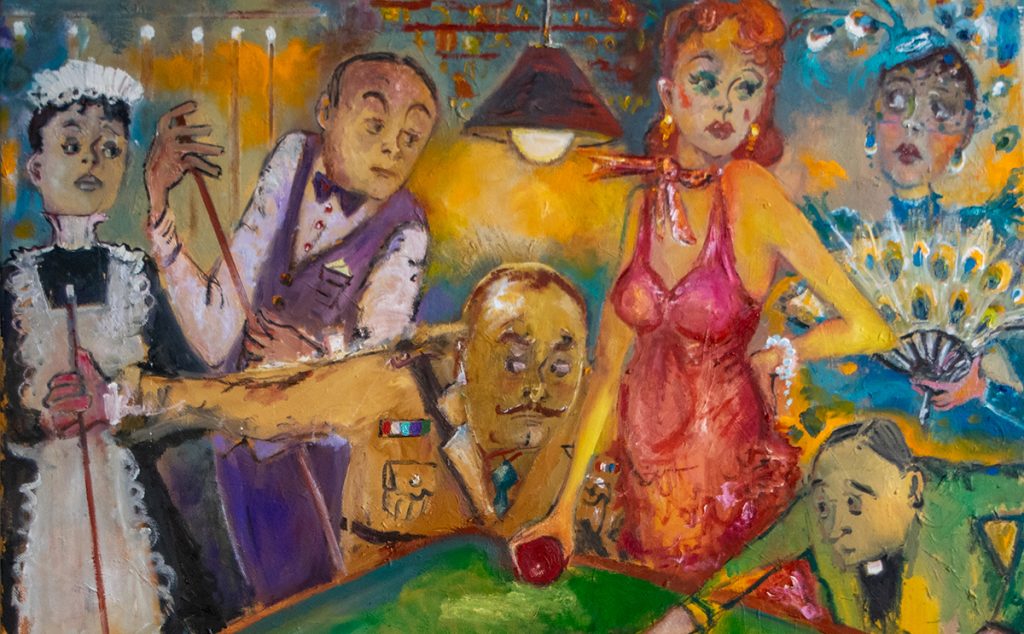Anna Mazzotta paints with the eye of a dramatist. She doesn’t chase what’s fashionable, nor does she fall into the trap of painting for applause. Instead, she studies the world like a playwright gathering characters and scenes, then lets her brush carry the story. Born in the UK with Italian roots, she carries both restraint and passion in her work. She splits her time between London and Bristol, and both cities leave their mark: London’s theater, cabaret, and smoky lounges, Bristol’s grit, humor, and working-class edge. Together, they shape her paintings into something that feels both familiar and otherworldly.

Her formal training came at the Royal College of Art. It gave her technique, rigor, and discipline. But the voice she developed doesn’t come from lecture halls. It comes from velvet curtains, crowded parlors, and whispered conversations in dim light. Mazzotta’s world is theatrical, yet never forced. She paints human behavior with a blend of affection and irony, capturing the comedy in refinement and the unease beneath civility.
Take The Billiard Room, one of her works from The Cluedo Collection. On the surface, it’s a social scene: a game of billiards, six suspects gathered in polite company. Yet something is off. The room hums with tension. Every face carries secrets. Every gesture hints at more than what’s spoken. Mazzotta doesn’t just set the stage—she fills it with atmosphere, with that invisible fog of intrigue you sense before anyone makes a move. It’s a painting that works like a short story, one you return to and find new cues each time.
This way of working comes from her method of observation. Mazzotta watches people closely, not for what they present but for what slips through the cracks—the smirk that undercuts the compliment, the silence that lingers a beat too long. These fragments find their way into her canvases. She doesn’t idealize her subjects; she reveals them. And in that exposure, she finds humor, vulnerability, and a shared humanity. It’s why her paintings feel alive. They aren’t just portraits or tableaux; they’re dramas mid-scene.
Italian heritage plays its part as well. The pull of opera, Fellini, and commedia dell’arte can be traced in her compositions. There’s a sense of exaggeration, of caricature, but never cruelty. She heightens reality in order to tell the truth more clearly. That instinct has a lineage: from Renaissance frescoes teeming with characters to the grand narratives of film. Mazzotta’s work belongs to that stream, using exaggeration not as distortion but as revelation.
Still, her art resists easy labels. It is neither nostalgia nor parody. Though her scenes may echo Edwardian parlor games or smoky cabaret halls, they are firmly rooted in the present. The anxieties, the performance of manners, the undercurrent of social games—they belong to now as much as to any past era. In that sense, her paintings act like mirrors. We recognize ourselves in them, dressed in different costumes but playing the same games.
Living between London and Bristol sharpens that sense. London feeds her with spectacle, the saturation of theater and nightlife. Bristol grounds her with humor and resilience. The balance keeps her work from drifting into pastiche. Instead, it stays taut, alive, and contemporary. She captures a world that is decadent but not empty, comic but not trivial.
What makes Mazzotta distinct is her refusal to let art stand apart from life. She paints people not as subjects on a pedestal but as characters already in motion, caught mid-gesture, mid-thought. The viewer becomes part of the room, another witness to the scene. Her paintings ask you to lean in, to catch the undercurrent, to fill in the missing dialogue. It’s this demand for engagement that keeps her work compelling. You don’t just look—you join.
In the end, Anna Mazzotta’s art doesn’t offer escape. It offers recognition. It shows us the theater of daily life, the comedy and drama we play out without realizing. By pulling back the curtain and setting it in oil on canvas, she gives us a chance to see it clearly, maybe even to laugh at ourselves. In her hands, painting becomes more than a record—it becomes a stage where truth wears a costume, and performance reveals the real.

